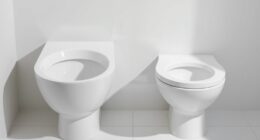Did you know that the average person flushes a toilet about five times a day? That adds up to a significant amount of water usage.
In this article, I will explore the fascinating world of toilet flushing and answer the question of how many gallons of water are needed for each flush.
We will delve into the historical background, discuss water conservation efforts, and provide practical tips on reducing water consumption without sacrificing cleanliness.
So let’s dive in and discover the secrets behind this everyday necessity.
Key Takeaways
- Ancient civilizations had toilet flushing systems but the flush toilet was invented in the 16th century.
- Advancements in plumbing and water pressure have improved flushing mechanisms.
- Water conservation technologies such as dual-flush toilets, low-flow toilets, pressure-assist toilets, and waterless toilets have been developed.
- Standards for flush volume have been implemented to regulate toilet efficiency and reduce water consumption.
Historical Background on Toilet Flushing
You might be surprised to learn that the historical background on toilet flushing dates back to ancient civilizations. Toilet flushing technology has come a long way since then, with the evolution of toilet designs being influenced by various factors.
In ancient Rome, for example, they used a system called the ‘cloaca maxima,’ which involved a network of drains and sewers to flush waste away.
Fast forward to the 16th century, and we see the invention of the flush toilet by Sir John Harington. This design used water to create a siphon effect, effectively flushing waste down the drain.
Over the years, advancements in plumbing and water pressure have led to more efficient flushing mechanisms, reducing the amount of water needed for each flush.
Today, we have high-efficiency toilets that use as little as 1.28 gallons per flush, saving water and helping the environment.
Water Conservation and Toilet Flushing
There’s a simple way to conserve water when you use the toilet. Here are four water-saving technologies that can improve toilet efficiency:
-
Dual-flush toilets: These toilets have two flush options, allowing you to choose a smaller flush for liquid waste and a larger flush for solid waste.
-
Low-flow toilets: These toilets use less water per flush compared to traditional toilets. They are designed to still effectively remove waste while reducing water consumption.
-
Pressure-assist toilets: These toilets use air pressure to help flush waste more efficiently, reducing the amount of water needed for each flush.
-
Waterless toilets: These innovative toilets do not use water at all. Instead, they use a composting system or incineration to dispose of waste.
By utilizing these toilet efficiency technologies, you can significantly reduce your water consumption and contribute to water conservation efforts.
Now, let’s explore the regulations on standard toilet flush volume.
Standard Toilet Flush Volume Regulations
One way to regulate toilet efficiency is by establishing standards for the volume of each flush. This helps to ensure that toilets are not using excessive amounts of water and contributes to water conservation efforts. Low flow toilets are designed to use less water per flush compared to traditional toilets, which can have a significant impact on water usage. These toilets typically have a maximum flush volume of 1.6 gallons, compared to the older models that used up to 5 gallons per flush. The table below illustrates the flush volumes for different types of toilets:
| Toilet Type | Flush Volume (gallons) |
|---|---|
| Low Flow Toilets | 1.6 |
| Traditional Toilets | 5 |
Factors Affecting Water Usage in Toilet Flushing
By regulating the volume of each flush, we can significantly impact the efficiency of toilet water usage. Water saving technologies and the design of toilets play a crucial role in reducing water consumption. Here are four factors that affect water usage in toilet flushing:
-
Flush volume: The amount of water used in each flush is a key factor. Low-flush toilets typically use around 1.6 gallons per flush, while older models can use up to 5 gallons.
-
Dual-flush toilets: These toilets offer two flush options – a partial flush for liquid waste and a full flush for solid waste. This allows users to choose the appropriate amount of water for each flush.
-
Pressure-assisted toilets: These toilets use pressurized air to create a forceful flush, reducing the need for excessive water. They are especially useful in commercial settings.
-
Efficient bowl and trapway design: The shape and size of the bowl and trapway affect the flushing performance. Efficient designs promote effective waste removal with minimal water usage.
Tips for Reducing Water Consumption in Toilet Flushing
To reduce water usage in flushing, there are a few options you can consider. One option is to use dual-flush toilets, which have two flushing options for liquid and solid waste. This allows you to use less water for liquid waste and more water for solid waste. Another option is to install composting toilets, which use little to no water and break down waste into compost. These toilets are environmentally friendly and can greatly reduce water consumption. By implementing these alternative methods, you can actively contribute to water conservation efforts while still effectively disposing of waste.
Conclusion
In conclusion, understanding how much water it takes to flush a toilet is essential for water conservation. By following standard toilet flush volume regulations, we can ensure that we are not wasting excessive amounts of water.
While some may argue that reducing water consumption in toilet flushing is inconvenient, it is important to remember that small changes can make a big difference. By implementing simple tips such as using a dual-flush toilet or installing a toilet tank displacement device, we can significantly reduce our water usage without sacrificing functionality.
Let’s all do our part in conserving water for a greener future.










